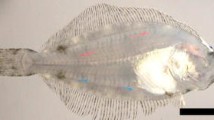Abstract
Rearing experiments were carried out to clarify the effects of sandy substrate and light irradiation on hypermelanosis of the blind side (the staining type of ambicoloration) in cultured Japanese flounder. Fish were reared in three experimental conditions: (1) no sandy substrate into which fish could bury themselves and with upward light irradiating their blind sides, (2) no sandy substrate and no upward light, and (3) sandy substrate (transparent glass sand) with upward light irradiation. Pigmented areas on the blind side were measured by an image analyzing system. Flounder from the third condition (sandy substrate with light irradiation) showed the lowest pigmentation on the blind side. In contrast, fish from the second condition (no sandy substrate and no light irradiation), showed the highest pigmentation coverage. These results indicate that sandy substrate on the bottom in culture tanks is more important than light irradiation as a factor affecting hypermelanosis of the blind side in cultured Japanese flounder.
Similar content being viewed by others
References cited
Burton, D. 1988. Melanophore comparisons in different forms of ambicoloration in the flatfish Pseudopleuronectes americanus and Reinhardtius hippoglossoides. J. Zool., Lond. 214: 353–360.
Cunningham, J.T. 1891. An experiment concerning the absence of color from the lower sides of flat-fishes. Zool. Anzeiger 14: 27–32.
Cunningham, J.T. 1893. Researches on the coloration of the skins of flat-fishes. J. Mar. Biol. Assoc. U.K. 3 (N.S.): 111–118.
Cunningham, J.T. 1895. Additional evidence on the influence of light in producing pigments on the lower sides of flat fishes. J. Mar. Biol. Assoc. U.K. 4 (N.S.): 53–59.
Gartner, J.V., Jr. 1986. Observations on anomalous conditions in some flatfishes (Pisces: Pleuronectiformes), with a new record of partial albinism. Env. Biol. Fish. 17: 141–152.
Houde, E.D. 1971. Developmental abnormalities of the flatfish Achirus lineatus reared in the laboratory. U.S. Fish. Bull. 69: 537–544.
Maruyama, K. 1976. Abnormal specimens of flatfishes collected in Iwate Pretecture. Japan. J. Ichthyol. 23: 118–120 (in Japanese).
Masaki, Y. H. Ito. 1984. Stock identification of finespotted flounder, Pleuronichthys cornutus in the western Seto inland sea. Bull. Nansei Reg. Fish. Res. Lab. 16: 11–51 (in Japanese).
Norman, J.R. 1934. A systematic monograph of the flatfishes (Heterosomata). Volume 1. Brit. Mus., London, 459 pp.
Osborn, C.M. 1940. The experimental production of melanin pigment on the lower surface of summer flounders (Paralichthys dentatus). Proc. Nat. Acad. Sci. U.S.A. 26: 155–161.
Osborn, C.M. 1941. Studies on the growth of integumentary pigment in the lower vertebrates I. The origin of artificially developed melanophores on the normally unpigmented ventral surface of the summer flounder (Paralichthys dentatus). Biol. Bull. Mar. Biol. Lab., Woods Hole 81: 341–351.
Seikai, T. 1985. Effect of population density and tank color on the abnormal coloration of hatchery-reared mud dab, Limanda yokohamae. Suisanzoshoku 33: 119–128 (in Japanese).
Seikai, T. 1991. Influences of fluorescent light irradiation, ocular side pigmentation, and source of fishes on the blind side pigmentation in the young Japanese flounder, Paralichthys olivaceus. Suizanzoshoku 39: 173–180 (in Japanese).
Stickney, R.R. D.B. White. 1975. Ambicoloration in tank cultured flounder, Paralichthys dentatus. Trans. Amer. Fish. Soc. 104: 158–160.
Suzuki, N. 1994. Ultrastructure of the skin on reverse side of hatchery-reared Japanese flounder, Paralichthys olivaceus with reference to the pigmentation. Bull. Nansei. Natl. Fish. Res. Inst. 27: 113–128 (in Japanese).
Takahashi, Y. 1994. Influence of stocking density and food at the late phase of the larval period on hypermelanosis on the blind body side in juvenile Japanese flounder. Nippon Suisan Gakkaishi 60: 593–598 (in Japanese).
Yamaguchi, M. 1955. Anomalies observed in flatfishes Paralichthys olivaceus and Paralichthys stellatus. Saishuu to Shiiku 17: 244 (in Japanese).
Yamamoto, S. T. Oda. 1991. The effects of several diets on survival, growth and color anomalies in juvenile flounders Paralichthys olivaceus. Bull. Fish. Exp. Sra. Okayama Pref. 6: 100–108 (in Japanese).
Author information
Authors and Affiliations
Rights and permissions
About this article
Cite this article
Iwata, N., Kikuchi, K. Effects of sandy substrate and light on hypermelanosis of the blind side in cultured Japanese flounder Paralichthys olivaceus. Environmental Biology of Fishes 52, 291–297 (1998). https://doi.org/10.1023/A:1007493913799
Issue Date:
DOI: https://doi.org/10.1023/A:1007493913799




